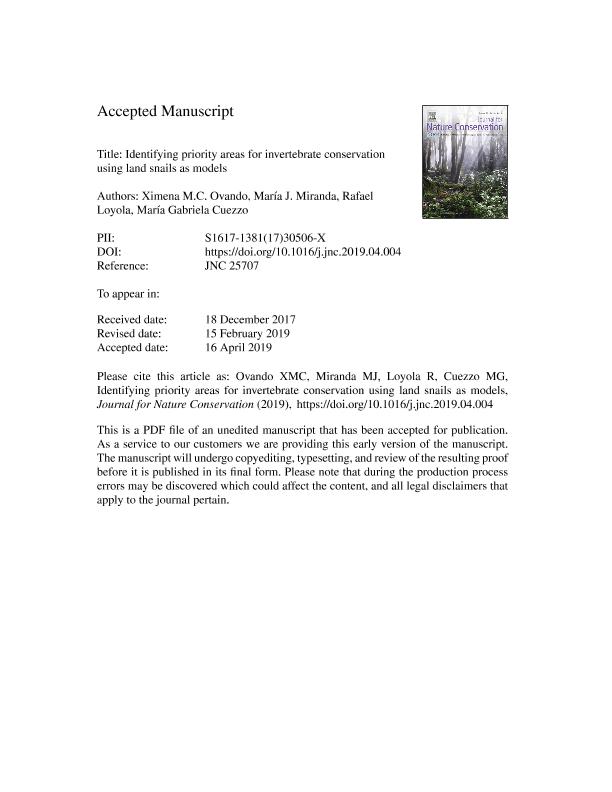Mostrar el registro sencillo del ítem
dc.contributor.author
Ovando, Ximena Maria Constanza

dc.contributor.author
Miranda, Maria Jose

dc.contributor.author
Loyola, Rafael

dc.contributor.author
Cuezzo, Maria Gabriela

dc.date.available
2021-12-09T12:45:37Z
dc.date.issued
2019-08
dc.identifier.citation
Ovando, Ximena Maria Constanza; Miranda, Maria Jose; Loyola, Rafael; Cuezzo, Maria Gabriela; Identifying priority areas for invertebrate conservation using land snails as models; Elsevier Gmbh; Journal for Nature Conservation; 50; 8-2019; 1-38
dc.identifier.issn
1617-1381
dc.identifier.uri
http://hdl.handle.net/11336/148467
dc.description.abstract
Mollusca is a megadiverse phylum with an estimated number of 70,000–76,000 described species which can inhabit a wide variety of environments. Among them, land snails are a main component of terrestrial ecosystems and they play a pivotal role in ecosystem functioning. They are suffering habitat loss, overexploitation and competition from introduced species, but are regarded as a “non-charismatic” group for conservation purposes. Orthalicoidea is a dominant faunal element in the Neotropics and in Argentina includes 104 species that inhabit a variety of environments. Their abundance, diversity, comprehensive taxonomy and widespread representation in different ecoregions makes this molluscan group an excellent model for biodiversity assessments. The database used here consisted of 985 unique geographic records of 104 species. Species distribution models were generated using the Maximum Entropy method and Zonation v 3.1 was used to evaluate the proposed conservation goals. Three analyses including species distributions, the current protected areas system (PAs) and the Human print layer were carried out. This allowed the identification of priority areas for conservation, the percentage of the species distribution under PAs and analysis of the potential impacts under current land use and in the priority areas detected above. Sixty-one species were modeled, and 59 of them were included in the priority area selection process due to their high area under curve (AUC) scores. Five high priority areas located in the different ecoregions, were identified: 1-dry Chaco, 2-humid Pampas, 3-Southern Andean Yungas, 4-Alto Paraná Atlantic Forests and 5-high Monte. A small percentage of the average distribution range of Orthalicoidean species (3%) was within the current protected areas. Highest-ranked priority areas for land snails are outside the current protected areas system. When human impact is considered, the priority areas are reduced in size and appear as small patches. However, highest priority areas for conservation continue being those detected in the above analyses. Most of the areas detected are used for economic purposes, creating conflicts of interest between the development of human activities and conservation. This study represents one of the first attempts to identify ecoregion level priority areas for a terrestrial invertebrate group. Further analyses, including new predictors and other molluscan taxa, would improve planning the conservation of poorly known invertebrate groups.
dc.format
application/pdf
dc.language.iso
eng
dc.publisher
Elsevier Gmbh

dc.rights
info:eu-repo/semantics/openAccess
dc.rights.uri
https://creativecommons.org/licenses/by-nc-nd/2.5/ar/
dc.subject
MOLLUSCA
dc.subject
ORTHALICOIDEA
dc.subject
PROTECTED AREAS
dc.subject
SPECIES DISTRIBUTION MODELLING
dc.subject
ZONATION
dc.subject.classification
Conservación de la Biodiversidad

dc.subject.classification
Ciencias Biológicas

dc.subject.classification
CIENCIAS NATURALES Y EXACTAS

dc.title
Identifying priority areas for invertebrate conservation using land snails as models
dc.type
info:eu-repo/semantics/article
dc.type
info:ar-repo/semantics/artículo
dc.type
info:eu-repo/semantics/publishedVersion
dc.date.updated
2020-11-19T21:47:15Z
dc.journal.volume
50
dc.journal.pagination
1-38
dc.journal.pais
Alemania

dc.journal.ciudad
Berlín
dc.description.fil
Fil: Ovando, Ximena Maria Constanza. Universidade do Estado de Rio do Janeiro; Brasil
dc.description.fil
Fil: Miranda, Maria Jose. Consejo Nacional de Investigaciones Científicas y Técnicas. Centro Científico Tecnológico Conicet - Tucumán. Instituto de Biodiversidad Neotropical. Universidad Nacional de Tucumán. Facultad de Ciencias Naturales e Instituto Miguel Lillo. Instituto de Biodiversidad Neotropical. Instituto de Biodiversidad Neotropical; Argentina
dc.description.fil
Fil: Loyola, Rafael. Universidade Federal de Goiás; Brasil
dc.description.fil
Fil: Cuezzo, Maria Gabriela. Consejo Nacional de Investigaciones Científicas y Técnicas. Centro Científico Tecnológico Conicet - Tucumán. Instituto de Biodiversidad Neotropical. Universidad Nacional de Tucumán. Facultad de Ciencias Naturales e Instituto Miguel Lillo. Instituto de Biodiversidad Neotropical. Instituto de Biodiversidad Neotropical; Argentina
dc.journal.title
Journal for Nature Conservation

dc.relation.alternativeid
info:eu-repo/semantics/altIdentifier/doi/https://doi.org/10.1016/j.jnc.2019.04.004
dc.relation.alternativeid
info:eu-repo/semantics/altIdentifier/url/https://www.sciencedirect.com/science/article/abs/pii/S161713811730506X
Archivos asociados
